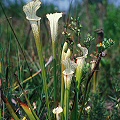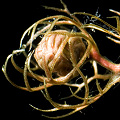Q: How can carnivorous plant habitat be destroyed?
A: It is distressingly easy to destroy carnivorous plant habitat. First, and most obviously, it
can be drained and turned into human structures like parking lots, stores, roads, golf courses,
and houses.
But even undeveloped, sites can be easily degraded or destroyed. If fire is an important part of the natural processes at
the site, fires must be allowed to pass through the area. If fire is suppressed, woody vegetation (the noncarnivorous plants at the
site) slowly and inevitably choke out the carnivorous plants.
Homes and buildings can use so much water that the
water table drops--obviously a death sentence for wetland plants.
Even if there is still plenty of water in developed areas, the water quality can suffer. When pollutants (such as
fertilizers, pesticides, or waste products) from
human homes, agriculture, or businesses enter the water, they can destroy
the carnivorous plants.
Carnivorous plant habitats are often extremely delicate. Over-visitation can damage delicate Sphagnum
mats, the very structure of the habitat.
Acid rain can poison carnivorous plant habitats. Yes, it is acidic, but not the right kind of acidic! Airborn pollutants
are rich in nitrogen, in essence a fertilizer. Again, very bad.
Fragmentation of large habitats into tiny, isolated sites is harmful, as it disrupts large-scale, landscape-level processes
such as fire, the movement of pollinators, and water flow.
Non-native invasive species can disrupt, displace, and destroy.
Global climate change---oh dear.
And the list goes on...
Page citations: Rice, B.A. 2006a.

